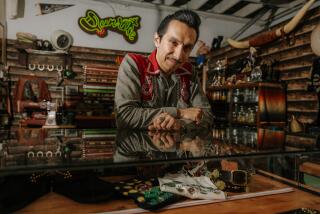Elizabeth J. Duquette; Artist and Socialite
Elizabeth Johnstone Duquette, an artist and the wife and partner of artist and set designer Tony Duquette, died Monday in Los Angeles. She was 77.
Mrs. Duquette, whose paintings were featured in the Elizabeth Taylor film “The Sandpiper,” had suffered from Parkinson’s disease.
The enigmatic, shy painter happily worked in her husband’s shadow. He was the only person permitted in her private studio, tucked away in the living and working environment that they created in Los Angeles. Their barn-like building formerly housed a sound stage used by actress Norma Talmadge.
“Tony can work with everything going on,” she told The Times in 1972. “I have to be by myself to work.”
She helped her husband create other studios in San Francisco and on their ranch in Ventura County. With no children of their own, they worked together to encourage and train young artists, often at the ranch.
Mrs. Duquette’s well-known nickname was “Beegle.” Her husband coined the term, he once explained, “because she has the industry of the bee and the soaring poetry of the eagle.”
Born in California and reared in Oregon and Washington, Mrs. Duquette attended the former Chouinard Art Institute in Los Angeles, where she met her future husband. World War II intervened, and they delayed any talk of marriage for several years.
“I didn’t think I would marry. I didn’t think I would ever find ‘the one,’ ” she said years later.
Their wedding in 1949 was done with their customary panache--in the flower-banked dining room of Pickfair, with their host Mary Pickford as matron of honor and her husband Buddy Rogers as best man. When guests arrived for what they expected to be a cocktail party, they found a bride and groom and the wedding reception.
Mrs. Duquette, who as an artist specialized in portraits and murals, worked only on commission and rarely exhibited her work. But she had huge audiences because of her efforts for film studios. In addition to “The Sandpiper,” she painted works for other films, including director Vincente Minnelli’s “Interlude” and “Goodbye Charlie.”
Known for painting airy scenes with frothy colors, she staged her largest exhibition in 1957 at San Francisco’s De Young Museum.
Mrs. Duquette, a much-photographed Beverly Hills socialite, often appeared on best-dressed lists and was sought out by such artistic photographers as Man Ray and couturiers such as Galanos and Givenchy.
Careful about lending her name to charitable causes, Mrs. Duquette was active in the Los Angeles Music Center’s Blue Ribbon 400 and the Costume Council of the Los Angeles County Art Museum. She also served on the board of the Elsie de Wolfe Foundation.
In 1979, she and her husband formed the Anthony and Elizabeth Duquette Foundation for the Living Arts, a nonprofit public foundation dedicated to presenting museum-quality exhibitions with artistic, scientific and educational value to the public.
Mrs. Duquette is survived by her husband. Private memorial services are planned.
More to Read
The biggest entertainment stories
Get our big stories about Hollywood, film, television, music, arts, culture and more right in your inbox as soon as they publish.
You may occasionally receive promotional content from the Los Angeles Times.










